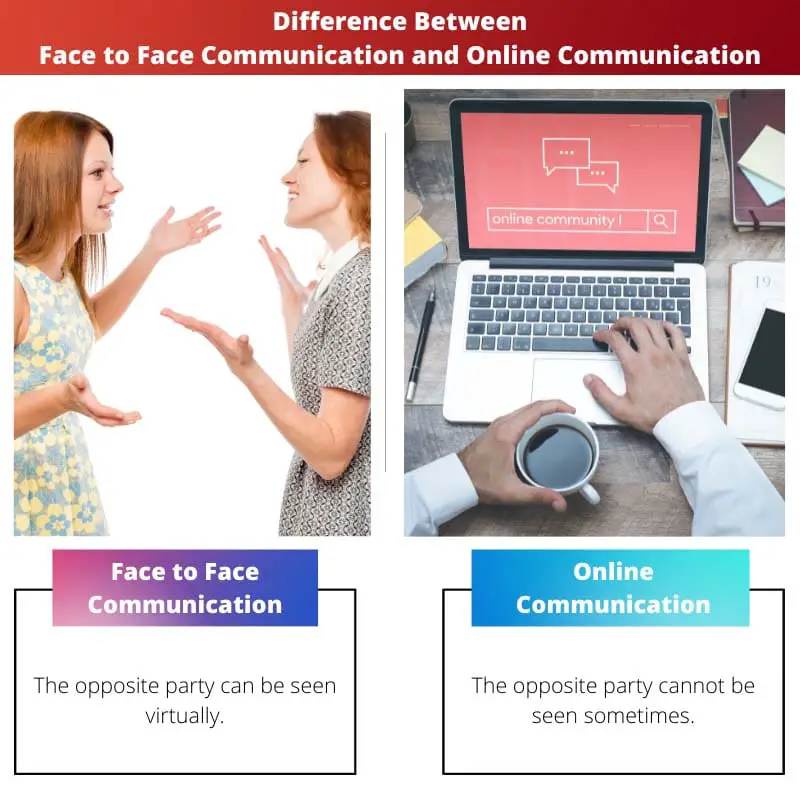Humans, by nature, are said to be social, enthusiastic living beings. Socializing and communicating with people is crucial to a human as food, water, and shelter are for our survival.
Communication can be done through both face-to-face and online methods.
Face-to-face communication enhances the quality of a person’s life, whereas online communication has a new domain of possibilities for communicating with people.
Key Takeaways
- Face-to-face communication involves direct, physical interaction, while online communication refers to using technology to communicate remotely.
- Face-to-face communication allows for more non-verbal cues, immediate feedback, and stronger personal connections, while online communication offers convenience, accessibility, and wider reach.
- The choice between face-to-face and online communication depends on the context, purpose, and individual preferences. Both forms of communication have their advantages and limitations.
Face to Face Communication vs Online Communication
The difference between face-to-face and online communication is that in the face to face communication, you can feel and see the presence of the other party, whereas, in online communication, you cannot see the other party with whom you are communicating.

Face-to-face communication is a traditional method that allows you to see the opposite party you are talking to.
This allows betterment in exchange for communication and information for a person and to whom he communicates.
Even though the technology today is remarkable many still follow this kind of communication for clarity. Face-to-face communication is an informal discussion between friends, family, colleagues, etc.
Online communication means when a person is communicating with another person via computer, using the internet through email, etc.
Due to technology development in a remarkable way, technology provides people with a significant way to communicate with other people and carry out their business.
We can talk and text anyone we want through mail anytime without boundaries for a person, whether the opposite person is online.
Comparison Table
| Parameters of comparison | Face-to-Face Communication | Online Communication |
|---|---|---|
| Presence | The opposite party can be seen virtually. | The opposite party cannot be seen sometimes. |
| Cost | The cost is comparatively low. | The cost is high due to the need for facilities for WiFi for the internet. |
| Speed | There is fast communication due to immediate feedback. | It comparatively has slow communication as a person has to wait for the response of the feedback. |
| Privacy | There is complete privacy in data and information exchanged. | There is no privacy for the data and information exchanged. |
| Type of communication | This is more used for informal communication. | This is more used for formal communication. |
What is Face-to-Face Communication?
When one person puts forward his views and communicates his opinion to some other person, and both exchange their opinions in the presence of both, this is called face-to-face communication.
In face-to-face communication, when people communicate, they get a speedy response immediately without any misunderstandings.
During this conversation, people can hear and see the feelings and facial expressions and know what context the opposite person is trying to talk about by observing his face.
Through face-to-face communication, people can better express their feelings and ideology. There is eye contact in this type of communication.
Statistics have shown that more than 70 per cent of people use face-to-face communication even with all the developing technology today.
Face-to-face communication is significant when it comes to the discussion of important things since there is immediate feedback from the opposite party.
We learn better skills on how to co-ordinate through face-to-face communication.
The major drawback of face-to-face communication is that when discussing a topic for a large group or large organization with many people, a person may go through difficulties, especially when various departments are at different places.

What is Online Communication?
Online communication is a platform where a person communicates with another person via a computer or w mobile using the internet through email, WhatsApp, etc.
Online communication has widely embraced and enhanced and brought our economy’s growth by bringing different languages and geographical boundaries together on one communication platform.
Through online communication, a business can communicate 24/7 with its clients, which means a person can start his business anytime and communicate worldwide.
Information is transformed quickly through online communication, which unquestionably saves lots of time and money.
Online communication has removed the gap of Social-cultural and language barriers, making it easier for a person to communicate globally.
It is cheaper to send mail or a WhatsApp text to someone from another country rather than a phone call.
The major drawback of online communication is that even though the internet has allowed connecting the entire work, some cultures have managed to customize others, giving teenagers in India a hand over Western culture by acting, behaving, and dressing like them.
Although online communication is quick and easy, there is no data privacy, and there is a high risk of insecurity of jobs.

Main Differences Between Face-to-Face Communication and Online Communication
- Face-to-face communication requires no cost, whereas online communication requires the cost to set internet, for which you need a WI-FI connection.
- Face-to-face communication has specific rigid deadlines, whereas online communication is more flexible.
- Face-to-face communication needs small and limited space, whereas online communication includes large organizations simultaneously.
- Face-to-face communication is used as an informal communication method, whereas online communication is used for formal communication.
- Data and information are private in face-to-face communication, whereas online communication has no privacy.





